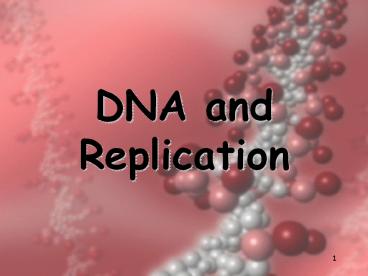DNA and Replication PowerPoint PPT Presentation
1 / 49
Title: DNA and Replication
1
DNA and Replication
2
- SCI.9-12.B-4.1 - Indicator - Compare DNA and
RNA in terms of structure, nucleotides, and base
pairs.
3
History of DNA
4
History of DNA
- Early scientists thought protein was the cells
hereditary material because it was more complex
than DNA - Proteins were composed of 20 different amino
acids in long polypeptide chains
5
Chargaffs Rule
- Adenine must pair with Thymine
- Guanine must pair with Cytosine
- The bases form weak hydrogen bonds
6
DNA Structure
- Rosalind Franklin took diffraction x-ray
photographs of DNA crystals - In the 1950s, Watson Crick built the first
model of DNA using Franklins x-rays
7
Rosalind Franklin
8
DNA Structure
9
DNA
- Two strands coiled called a double helix
- Sides made of a pentose sugar Deoxyribose bonded
to phosphate (PO4) groups by phosphodiester bonds - Center made of nitrogen bases bonded together by
weak hydrogen bonds
10
DNA Double Helix
11
DNA
- Stands for Deoxyribonucleic acid
- Made up of subunits called nucleotides
- Nucleotide made of
- 1. Phosphate group
- 2. 5-carbon sugar
- 3. Nitrogenous base
12
Pentose Sugar
- Carbons are numbered clockwise 1 to 5
13
DNA Nucleotide
O
14
DNA
15
Antiparallel Strands
- One strand of DNA goes from 5 to 3 (sugars)
- The other strand is opposite in direction going
3 to 5 (sugars)
16
- SCI.9-12.B-4.1 - Indicator - Compare DNA and
RNA in terms of structure, nucleotides, and base
pairs.
17
Nitrogenous Bases
- Double ring PURINES
- Adenine (A)
- Guanine (G)
- Single ring PYRIMIDINES
- Thymine (T)
- Cytosine (C)
18
Base-Pairings
- Purines only pair with Pyrimidines
- Three hydrogen bonds required to bond Guanine
Cytosine
19
Two hydrogen bonds are required to bond Adenine
Thymine
20
Question
- If there is 30 Adenine, how much Cytosine is
present?
21
Answer
- There would be 20 Cytosine
- Adenine (30) Thymine (30)
- Guanine (20) Cytosine (20)
- Therefore, 60 A-T and 40 C-G
22
DNA Replication
23
Replication Facts
- DNA has to be copied before a cell divides
- DNA is copied during the S or synthesis phase of
interphase - New cells will need identical DNA strands
24
Synthesis Phase (S phase)
- S phase during interphase of the cell cycle
- Nucleus of eukaryotes
25
DNA Replication
- Begins at Origins of Replication
- Two strands open forming Replication Forks
(Y-shaped region) - New strands grow at the forks
26
DNA Replication
- As the 2 DNA strands open at the origin,
Replication Bubbles form - Eukaryotic chromosomes have MANY bubbles
- Prokaryotes (bacteria) have a single bubble
27
DNA Replication
- Enzyme Helicase unwinds and separates the 2 DNA
strands by breaking the weak hydrogen bonds - Single-Strand Binding Proteins attach and keep
the 2 DNA strands separated and untwisted
28
DNA Replication
- Enzyme Topoisomerase attaches to the 2 forks of
the bubble to relieve stress on the DNA molecule
as it separates
29
- SCI.9-12.B-4.1 - Indicator - Compare DNA and
RNA in terms of structure, nucleotides, and base
pairs.
30
DNA Replication
- Before new DNA strands can form, there must be
RNA primers present to start the addition of new
nucleotides - Primase is the enzyme that synthesizes the RNA
Primer - DNA polymerase III can then add the new
nucleotides
31
(No Transcript)
32
DNA Replication
- DNA polymerase III can only add nucleotides to
the 3 end of the DNA - This causes the NEW strand to be built in a 5
to 3 direction
Direction of Replication
33
Remember HOW the Carbons Are Numbered!
34
Remember the Strands are Antiparallel
35
Synthesis of the New DNA Strands
- The Leading Strand is synthesized as a single
strand from the point of origin toward the
opening replication fork
36
(No Transcript)
37
- SCI.9-12.B-4.1 - Indicator - Compare DNA and
RNA in terms of structure, nucleotides, and base
pairs.
38
Synthesis of the New DNA Strands
- The Lagging Strand is synthesized discontinuously
against overall direction of replication - This strand is made in MANY short segments It is
replicated from the replication fork toward the
origin
39
Joining of Okazaki Fragments
- The enzyme DNA Ligase joins the Okazaki fragments
together to make one strand
40
Lagging Strand Segments
- Okazaki Fragments - series of short segments on
the lagging strand - Must be joined together by an enzyme
41
Removing the primer
- DNA polymerase I will remove the RNA primer and
replace it with the correct DNA bases. DNA ligase
will then connect these new bases to the rest of
the DNA molecule
42
Replication of Strands
Replication Fork
Point of Origin
43
Proofreading New DNA
- DNA polymerase initially makes about 1 in 10,000
base pairing errors - Enzymes (DNA polymerase II) proofread and correct
these mistakes - The new error rate for DNA that has been
proofread is 1 in 1 billion base pairing errors
44
Semiconservative Model of Replication
- Idea presented by Watson Crick
- The two strands of the parental molecule
separate, and each acts as a template for a new
complementary strand - New DNA consists of 1 PARENTAL (original) and 1
NEW strand of DNA
45
- SCI.9-12.B-4.1 - Indicator - Compare DNA and
RNA in terms of structure, nucleotides, and base
pairs.
46
DNA Damage Repair
- Chemicals ultraviolet radiation damage the DNA
in our body cells - Cells must continuously repair DAMAGED DNA
- Excision repair occurs when any of over 50 repair
enzymes remove damaged parts of DNA - DNA polymerase II and DNA ligase replace and bond
the new nucleotides together
47
Question
- What would be the complementary DNA strand for
the following DNA sequence? - DNA 5-CGTATG-3
48
Answer
- DNA 5-GCGTATG-3
- DNA 3-CGCATAC-5
49
(No Transcript)

